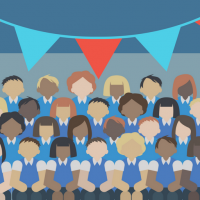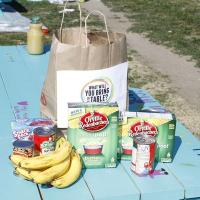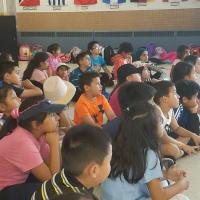Whether you are in a school, home, faith-based, or community setting, your group can build community through brief check-ins. Check-in meetings may last between 3-15
Duration: One 20-minute introduction, and a revisit on each birthday throughout the year.
Objectives:
The learners will...
- experience the importance and joy of doing for others.
- feel capable of ...
Children spend time outside to play in nature and recognize the beauty of diverse living things in their environment. Their service project is to share nature with someone else in a creative interaction.
- Read more about The World Outside
- Log in or register to post comments
Learners use visual literacy skills to talk about an artistic image. They listen respectfully to the different opinions and perspectives of their peers. They identify a need in their school or community and create a simple image that tells others to think differently or take action to improve that need.
- Read more about Listening Takes Heart
- Log in or register to post comments
Learners research the environmental effect of crayons and their own power to make an impact. They collect gently used crayons from restaurants and other places in the community. They sort them by color, repackage them for re-use, add a kind note, and donate the new packages where they identify a need. This elementary lesson includes an art lesson with crayons, pictured here. This lesson is enhanced when it involves collaboration between different age groups.
- Read more about Look What Trash Can Create!
- Log in or register to post comments
The handouts below are evaluations that may be completed by parents and families, community partners, students, and teachers. These evaluations may be used in conjunction with any Learning to Give lesson, toolkit, or resource. The goal is to help you collect information about the...
We often hear about the importance of eating three healthy meals a day, however, some of us do not have the resources to even eat one. The problem with hunger and malnutrition is more complex than access to healthy food. It is complicated by multiple societal issues that we can address. Youth are equipped with a voice, heart, and hands to take big and small actions for a meaningful purpose to help raise awareness of and fight the issues of hunger and malnutrition.
In spite of the diverse roots that make up our country, some immigrants who come for opportunity and refugees who are forced to leave their homes are treated with disrespect or even cruelty. Young people have the opportunity to speak up and raise awareness of the beauty of diversity and value of embracing people of all backgrounds and situations. This toolkit guides youth, educators, group leaders, families, and community groups as they investigate the issue of immigration and refugees and prepare to take action.
Young people investigate the problems caused by plastic shopping bags, then propose solutions to address the problems. This lesson prompts teams to design a reusable shopping tote out of an old T-shirt using engineering, problem-solving, creativity, and communication. They take action for the common good by using and sharing their project and by educating the community about problems and solutions to the plastic bag crisis.
- Read more about Tote Challenge
- Log in or register to post comments
In civil society, different people come together to form community. While differences may cause conflict, for the sake of the common good, we practice empathy and respect for others. We use literature to talk about how people from different perspectives see the same thing. We discuss how to communicate respectfully with someone of a different opinion and to seek common ground or compromise. The service project is to create posters that bring people together.
- Read more about Resolving Conflict with Respect - Elem
- Log in or register to post comments



